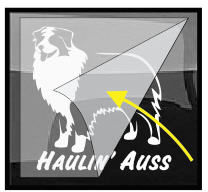NickerStickers Decals are Easy to Apply!Whether you've never, ever applied a decal before or are an old pro, NickerStickers go on smooth and easy and stick very well.
Before you start, WASH THE SURFACE!
Don't Use Window Cleaner!
We recommend you use plain old soap and water, 1/3 cup soap to 1 cup water. If there is any wax build up, use a scrubby. Finish with a lint free cloth to dry. You can add additional touch of extra cleaning with rubbing alcohol, mixed half and half with water. But soap and water is usually good enough.
Step 1. Peel the transfer tape with the decal stuck to it away from the waxy backing paper. The adhesive side of your decal is now exposed. Be careful! Don't get it dirty and don't touch it with your fingers. Use the clear transfer tape to hold because you'll be taking that off later anyway.

Step 2. Using the transfer tape, roll your decal on to the surface to which you are applying, starting at one corner and laying it down. Once it is on the surface, rub on top of the clear transfer tape and decal using a credit card and working from the center out. Press lightly at first, then repeat more firmly. Repeat several times.

Step 3. REMOVE THE TRANSFER TAPE. The decal is under the transfer tape. Pull the transfer tape up at a sharp angle beginning at one corner. Remove the clear tape on top of the decal and throw it away. Your decal should easily stick to the surface while you are pulling up the transfer tape. If it's not sticking solid, try leaving it on overnight and taking it off the next day.

For more information on decal application, including applying large decals,
video instruction, and trouble shooting, click here:

The Rat Terrier is a rare breed officially recognized by the UKC in 1999 and the AKC in 2012. This American bred dog gets its name from their original occupation of hunting rats. Rat Terriers were cherished as loyal hunting companions and efficient killers of vermin on 20th century American farms: as a result, they were one of the most popular dog types from the 1920s to the 1940s. However the widespread use of chemical pesticides and the growth of commercial farming led to a sharp decline in the breed from the 1950s onwards. Breed loyalists maintained the bloodline, leading to the modern Rat Terrier.
The genetic diversity of the Rat Terrier has contributed to the overall health, keen intelligence, and soundness of the breed. Most modern breeds were developed from a few founding dogs and then propagated from a closed gene pool. In contrast, the Rat Terrier has benefited from a long history of refinement with regular outcrosses to bring in useful qualities and genetic variability.
Rat Terriers are very trainable and easier to live with for the average pet owner. They are also considered good family pets because of their high energy and compatibility with kids.They are very playful and they need very much exercise. Extensive socialization from an early age is critical. Like most active and intelligent breeds, Rat Terriers tend to be happier when they receive a great deal of mental stimulation and exercise.